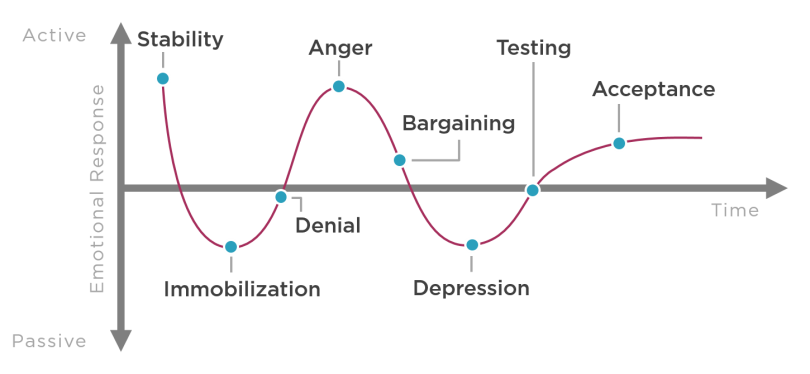Welcome back to our series on how to help employees navigate change inside your organization.
We’ve established that change brings out many emotions in people — and while some will be excited, many will have anxiety about the shift. Reaction to change is likely to be emotional rather than rational, and past experiences will influence the current situation. Understanding this emotional curve will help you navigate change and assist others to do so as well.

Note: To see Kevin teach this series on video, check out his course, Managing IT: Organizational Change Management, on Pluralsight.
Where Anger Comes From
As the most active of all the stages, anger elicits strong emotional responses, and it’s typically the most stressful stage for a manager because it can lead to uncomfortable confrontations and self-doubt. Without strong leadership, too much anger can lead to chaos within a team or an organization.
In the beginning, you should view anger as a positive, since it represents someone leaving the denial stage and accepting that the change is actually going to happen. Obviously, too much anger — or anger that exists for too long — can be detrimental to a team. But if properly managed, the people who express the most anger can become the change’s biggest and most vocal supporters, often helping to convert others into supporters.
The anger stage is natural and unavoidable, but it can be short. A good leader embraces it, since it shows progress and provides you an opportunity to help.
When viewed as an opportunity to gain a vocal supporter, helping someone through the anger stage morphs from an exhausting exercise to one that is a challenge.
How Leaders Deal With Doubt
Common Phrases Heard in the Anger Stage
- “This isn’t fair. This isn’t smart. This is a bad decision.”
- “I shouldn’t have to change. I won’t change.”
- “Why do we have to change, but they don’t?”
- “I’m going to talk to my boss’s boss or HR about this.”
How to Support Someone in the Anger Stage
- Do plan for this stage early — and on an individual level — by using what you learned from listening to and watching people in the denial stage to prepare your responses to their objections in the anger stage.
- Do communicate more detailed information to mitigate objections quickly.
- Don't use authority to attempt to squash people’s anger; you’ll just make them angrier.
- Don't allow any behaviors that go against your organization's values.
How to Help Employees Move on From Anger
- Allow people to express their anger, but monitor closely to make sure it doesn’t become destructive.
- Provide support to prevent people from slipping back into the denial stage.
- Continue to reinforce that the change is going to happen, but remain empathetic to their unique situation.
Putting It Into Practice
Look back on your positive and negative change notes from the previous article. For each of those changes, write down how long you think you were in the anger stage and who or what helped you exit it. Write down what was done to help you overcome your anger.
The Urge to Bargain
The bargaining stage provides an opportunity for a shortcut, but it can easily backfire if you don’t think it through. People in this phase are starting to accept that the change is going to happen, but will try to delay the impact on themselves — or avoid the change altogether. Their energy levels will slowly decrease as their anger fades away.
It is natural to want to meet someone with whom you share a personal connection with halfway, as they start negotiating to keep aspects of the current state intact. However, agreeing to a request, only to later overturn it, will pull someone back into a longer and more active anger stage. You will lose their trust and the trust of the people closest to them, which ultimately adds stress to the situation.
Too much empathy leads to hasty decisions, which tend to be reversed. Be kind but firm.
Common Phrases Heard in the Bargaining Stage
- “Can I first finish what I already started?”
- “I’ll do X the new way, but can I still do Y the old way?”
- “I think my skill set would be more valuable to the company in a different role or department.”
- “I’m on board, but I already made commitments and cannot miss those.”
How to Support Someone in the Bargaining Stage
- Do listen and provide support.
- Don't give into a request because simply it is easy or you feel sorry for someone.
- Do keep an open mind and seek out win-win scenarios.
- Don't make any promises.
How to Help Someone Move on From Bargaining
- When researching potential win-win scenarios, communicate updates frequently.
- If someone has a valid idea, prepare them for it to be altered if implemented.
- Explore ways to redistribute or reprioritize existing responsibilities so they can engage and contribute.
The Art of the Win-win
Find win-wins by implementing someone’s suggestion. Even if it’s just in part, you’ll reduce the depth and length of their depression stage, and you’ll have a good chance of moving someone into the testing stage, which is when they start to buy-in. But remember: Reversing your position on the suggestion later will pull someone back into the anger stage.
Putting It Into Practice
Here are your prompts for this stage: What were some of the suggestions you presented while bargaining? How were they perceived by your leadership? Were any of your suggestions implemented? Were any of the implementations later reversed? How did you feel about your leadership when they agreed or disagreed with your suggestions? In hindsight, did leadership make the right decisions?
Up next: We’ll explore depression, testing and acceptance.





